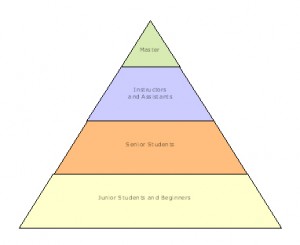The technical basis of most martial arts is full of complex concepts if compared to many other physical disciplines and sports.
Just think about the number of different strikes that karate, tae kwon do or a kickboxing practitioners have to master or the number of throws that a judo or a aikido students have to learn. Teaching and learning all moves that a martial art style involves requires a specific approach in the way they are taught. That’s why the organizational structure of a typical martial arts club is usually different from what is found in other sports clubs and organizations.
The structure of a martial arts club (or school) can be usually seen as having a pyramidal shape where the master (or head coach) is at the top of the pyramid and progressively, at lower levels, are individuals that belong to various ranks like instructor, assistants and other senior students that by definition contribute to the transfer of knowledge. New students and beginners should usually represent the largest group of people: these will progressively improve they knowledge and climb the ranks. This concept is important to express that not just master and instructors are taking part in the transfer of knowledge but also the remaining students that, once they learn a new concept, they should be able to explain it and transfer it to others.


Hi Massimo, Do you think knowledge tranfers up the pyramid as well as down? Some teachers, not just martial arts instructors, say they learn a lot from their students also.
@ James Bush
You are perfectly right. Teaching forces to learn better how techniques work and developing different ways of explaining the same concept because different people learn in different ways.
Pingback: Transfer of knowledge: the pyramidal structure of a martial arts school :: CARISMA